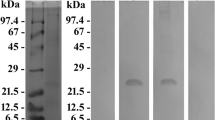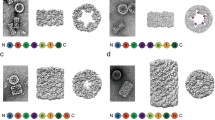Abstract
The blue mesogleal pigment of the symbiotic jellyfish, Cassiopea xamachana Bigelow, 1882, is composed of two subunits, a larger glycosylated (35 kDa) moiety and a non-glycosylated (30 kDa) variant in lower concentration. In solution, the subunits assemble in large complexes of at least 106 kDa. The pigment, known as Cassio Blue, appears to mitigate excessive solar radiation while allowing the passage of the wavelengths optimal for photosynthesis by the numerous algal symbionts in the mesoglea of the jellyfish. The pigment is an abundant protein comprising about 6% of all animal protein in the whole jellyfish and about 33% of all animal protein in the oral appendages. The protein also contains a diverse array of metals, notably Ag, Ca, Cu, Fe, Mg, and Zn, with traces of others. Metal stoichiometry varies among isolates averaging about 1 mol of all metals, taken together, for each mole of the pigment. Given the broad array of metals present, the pigment may also serve another purpose, for example, as a metal reservoir or trap. Few other proteins are associated with such a spectrum of metals. In addition, the amino acid sequences of the pigment tryptic peptides have no reasonable matches in any of the sequence databases. Our findings, taken as a whole, suggest that the Cassio pigment is indeed unusual and is likely a representative of a novel category of proteins, the original member of which is rpulFKz1, a chromoprotein endowed with Frizzled and Kringle domains.
Similar content being viewed by others
References
Ahles MD (1967) Some aspects of the morphology and physiology of Symbiodinium microadriaticum. Doctoral Dissertation, Fordham University, New York
Beauchamp CO, Fridovich I (1973) Isozymes of superoxide dismutase from wheat germ. Biochim Biophys Acta 317:50–64
Blanquet RS, Phelan MA (1987) An unusual blue mesogleal protein from the mangrove jellyfish Cassiopea xamachana. Mar Biol 94:423–430
Bradford MM (1976) A rapid and sensitive method for the quantitation of microgram quantities of protein utilizing the principle of protein-dye binding. Anal Biochem 72:248–254
Brown JP, Perham RN (1976) Selective inactivation of the transacylase components of the 2-oxo acid dehydrogenase multienzyme complexes of Eschericia coli. Biochem J 155:419–427
Bulina ME, Lukyanov KA, Yampolsky IV, Chudakov DM, Staroverov DB, Shcheglov AS, Gurskaya NG, Lukyanov S (2004) New class of blue animal pigments based on Frizzled and Kringle protein domains. J Biol Chem 279:43367–43370
Laemmli UK (1970) Cleavage of structural proteins during assembly of the bacteriophage T4. Nature (Lond) 227:680–685
Lavelle F, McAdam ME, Fielden FM, Roberts PB, Puget K, Michelson AM (1977) A pulse-radiolysis study of the catalytic mechanism of the iron-containing superoxide dismutase from Photobacterium leiognathi. Biochem J 161:3–11
McCord J, Fridovich I (1969) Superoxide dismutase: an enzymic function for erythrocuprein (hemocuprein). J Biol Chem 244:6049–6055
Phelan M, Boykins R, Gray I (1984) Modification of glyceraldehyde-3-phosphate dehydrogenase, E.C. 1.2.1.1.2, isolated from rainbow trout acclimated to 5C or 15C II. Biochemical characterization of G3PDH muscle isolates. Comp Biochem Physiol 79B:139–146
Phelan MA, Hall JW, Mayner RE (1986) Determination of protein concentration: comparison of simple colorimetric and fluorometric techniques. Biotechniques 4:130–136
Thuesen EV, Rutherford LD Jr, Brommer PL, Garrison K, Gutowski MA, Towanda T (2005) Intragel oxygen promotes hypoxia tolerance of scyphomedusae. J Exp Biol 208:2475–2482
Acknowledgements
We thank our colleagues Dr. Ann McDermott for preparing the purified Cassio Blue and the whole homogenates of jellyfish tissues; Oliver Ashe for the densitometric evaluations of proteins resolved by SDS-PAGE; Dr. Jacqueline Muller for electron microscopy; Alicia Stanton for the alanine aminotransferase assays. We also note the RCMI Environmental Toxicology Program, Ponce School of Medicine for initial ICP analyses; the NIH-MBRS Program grant award (5 S06 GM08239-10) to J.L.M. for financial support. The sequencing work was supported partially by a grant provided by the W. M. Keck Foundation and the University of Virginia Pratt Committee. The authors declare that the experiments covered in this paper comply with current US laws governing the conduct of research.
Author information
Authors and Affiliations
Corresponding author
Additional information
Communicated by J.P. Grassle, New Brunswick
Rights and permissions
About this article
Cite this article
Phelan, M.A., Matta, J.L., Reyes, Y.M. et al. Associations between metals and the blue mesogleal protein of Cassiopea xamachana . Marine Biology 149, 307–312 (2006). https://doi.org/10.1007/s00227-005-0189-9
Received:
Accepted:
Published:
Issue Date:
DOI: https://doi.org/10.1007/s00227-005-0189-9




